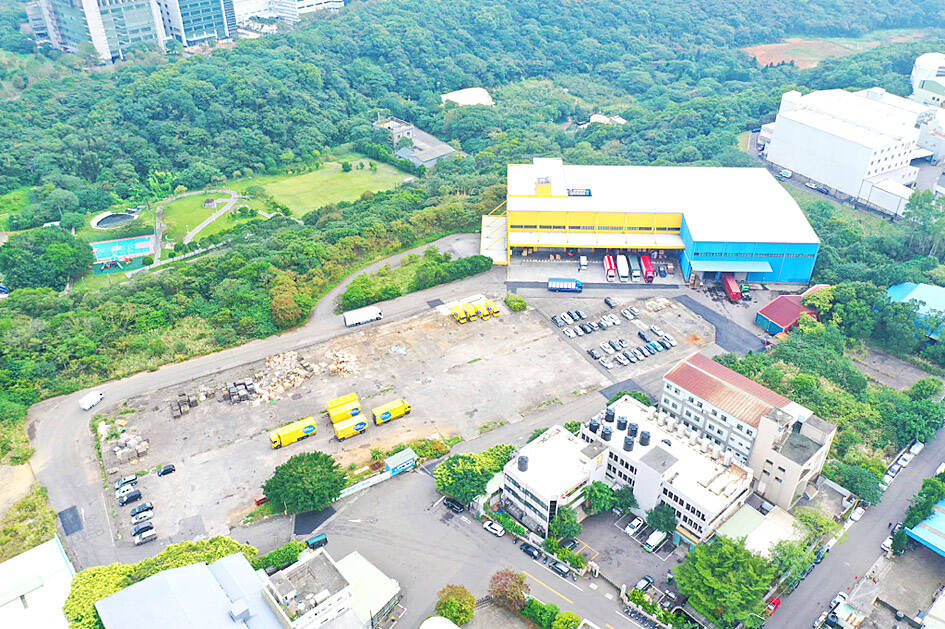Land prices in Taiwan’s industrial parks grew steeply in the past five years, which was driven by global supply chain realignment, reshoring of Taiwanese firms and demand from foreign technology firms, property consultancy Colliers International Taiwan (高力國際) said in a report yesterday.
The trend might sustain and lend more support to industrial land prices despite slow transactions this year, as firms spend cautiously amid economic uncertainty, Colliers said.
Industrial land transactions totaled NT$651.2 billion (US$20.4 billion) in the past five years with prices more than doubling in areas where land prices were previously cheap, Colliers said, after surveying 15 industrial parks in New Taipei City, Taoyuan, Hsinchu, Taichung, Tainan and Kaohsiung.

Photo courtesy of Colliers International Taiwan
Land prices soared by 20 percent to 125 percent and the increases were most conspicuous in southern Taiwan owing to low bases, it said.
Land prices for Kaohsiung’s Benjhou Industrial Park (本洲產業園區) spiked more than twofold, followed by Tainan’s Madou Industrial Park’s (麻豆工業區) 89 percent increase and Kaohsiung’s Dafa Industrial Park’s (大發工業區) 56 percent gain, it said.
The pace of growth reached 20 percent elsewhere in the nation, it said.
Taoyuan, with 34 industrial parks, tops other special municipalities in both industrial land supply and demand, consistent with its status as Taiwan’s manufacturing hub, Colliers said.
Industrial land deals in Taoyuan amounted to NT$158.7 billion from 2018 to the first half of this year, driven by reshoring of manufacturing facilities previously in China in the wake of US-China trade frictions, it said.
Hsinchu, Taichung, Tainan and Kaohsiung also benefited from supply chain realignment and capacity expansions of major local tech firms, it added.
By value, industrial plots in New Taipei Industrial Park (新北產業園區) ranked as the most expensive at NT$950,000 to NT$1.1 million per ping (3.3m2), it said, adding that Tucheng Industrial Park (土城工業區) and Hwa Ya Technology Park (華亞科技園區) tied for second place at NT$550,000 to NT$600,000 per ping.
Linkou Gong’er Industrial Park (林口工二工業區) was in the third place at NT$450,000 to NT$500,000 per ping, Colliers said.
It is no longer possible to find industrial plots valued at below NT$100,000 per ping anywhere in Taiwan, it said.
Industrial output at the Southern Taiwan Science Park (南部科學園區) hit NT$458.4 billion in the first four months of this year, surpassing that at Hsinchu Science Park (新竹科學園區) and Central Taiwan Science Park (中部科學園區), after semiconductor equipment supplier ASML Holding NV, chipmaker United Microelectronics Corp (聯電) and Applied Materials Taiwan added a presence, it said.
The southward migration of property funds would continue, thanks to a lack of land supply and increasing unaffordability in northern Taiwan, it said.

Taiwan Semiconductor Manufacturing Co (TSMC, 台積電) yesterday said that its investment plan in Arizona is going according to schedule, following a local media report claiming that the company is planning to break ground on its third wafer fab in the US in June. In a statement, TSMC said it does not comment on market speculation, but that its investments in Arizona are proceeding well. TSMC is investing more than US$65 billion in Arizona to build three advanced wafer fabs. The first one has started production using the 4-nanometer (nm) process, while the second one would start mass production using the

When an apartment comes up for rent in Germany’s big cities, hundreds of prospective tenants often queue down the street to view it, but the acute shortage of affordable housing is getting scant attention ahead of today’s snap general election. “Housing is one of the main problems for people, but nobody talks about it, nobody takes it seriously,” said Andreas Ibel, president of Build Europe, an association representing housing developers. Migration and the sluggish economy top the list of voters’ concerns, but analysts say housing policy fails to break through as returns on investment take time to register, making the

‘SILVER LINING’: Although the news caused TSMC to fall on the local market, an analyst said that as tariffs are not set to go into effect until April, there is still time for negotiations US President Donald Trump on Tuesday said that he would likely impose tariffs on semiconductor, automobile and pharmaceutical imports of about 25 percent, with an announcement coming as soon as April 2 in a move that would represent a dramatic widening of the US leader’s trade war. “I probably will tell you that on April 2, but it’ll be in the neighborhood of 25 percent,” Trump told reporters at his Mar-a-Lago club when asked about his plan for auto tariffs. Asked about similar levies on pharmaceutical drugs and semiconductors, the president said that “it’ll be 25 percent and higher, and it’ll

CHIP BOOM: Revenue for the semiconductor industry is set to reach US$1 trillion by 2032, opening up opportunities for the chip pacakging and testing company, it said ASE Technology Holding Co (日月光投控), the world’s largest provider of outsourced semiconductor assembly and test (OSAT) services, yesterday launched a new advanced manufacturing facility in Penang, Malaysia, aiming to meet growing demand for emerging technologies such as generative artificial intelligence (AI) applications. The US$300 million facility is a critical step in expanding ASE’s global footprint, offering an alternative for customers from the US, Europe, Japan, South Korea and China to assemble and test chips outside of Taiwan amid efforts to diversify supply chains. The plant, the company’s fifth in Malaysia, is part of a strategic expansion plan that would more than triple